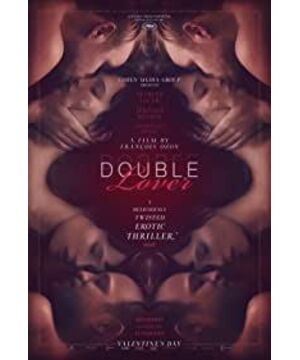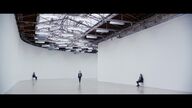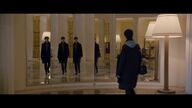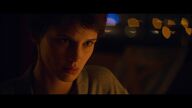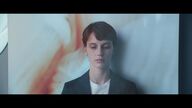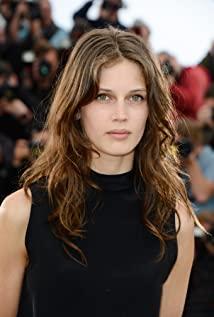Why Chloe's New Career as Conservator at the Contemporary Art Museum in Two Sides. This pure white, alienated space filled with contemporary art works seems to have stimulated her psychological alienation tendency. An obvious shot is of Chloe going to work with deep dark circles under her eyes after the first night of living together, sitting in two contemporary artworks with her eyes closed and the space around her seeming to melt into her mind , something is catalyzing and brewing. When the eyes are opened again, it is already on the bus, and the warm tones of the sunset form a contrast with the museum space. However, at this moment, she "sees" her imagined brother for the first time.
The museum space forms a closed space that is isolated from the external real world. (Although the museum is actually real), she looks confident, strong, and in control of the initiative in a black suit. She gradually brought these psychological states into the imaginary space of psychotherapy with her brother, and this imaginary space also acquired the cool characteristics of black, white and gray, which formed a sharp contrast with the warm tone of the diagnosis and treatment room of her brother in reality. During her brother's diagnosis and treatment, she also gradually changed from being completely passive to being active. To use her mother's words to describe her "fragile" personality, she gradually became cold, determined and aggressive in this imaginary space. In reality, her relationship with her "brother" is actually relatively weak and dependent on each other.
Another impressive thriller powered by contemporary art is 2017's Tom Ford's Nocturnal Animals, in which the heroine's career simply turns into a contemporary art gallery owner. The film opens with the opening of the gallery. A group of huge video works of obese naked women dancing are played in slow speed, which strongly challenges people's perception and sets the tone of the film. The gallery space, which is equally cold and alienated with black, white and gray as the main tone, also extends and metaphors the psychological space of the heroine. In this film, the function of contemporary artworks as a metaphor for the heroine's psychological state is even more pronounced. More shots are used when the female protagonist looks at the artwork or is juxtaposed with the work.
I don't know where it started, but in the eyes of the general public, contemporary art is going farther and farther in challenging the limits of people's physical perception. It seems that this is the only way to show sharpness and depth. And because of the ambiguous and ambiguous nature of these works, it is also convenient for the author to use them to refer to the alienated psychology in the thriller, and it is more suitable to exaggerate the suppressed emotions.
In this film, the museum space plays a considerable role as the basis and complement of the real space for the heroine's imagination. But there is still no logical explanation for what the heroine imagined. According to my understanding, the psychiatrist's brother and their mutual girlfriend Sandra are all the imagination of the heroine. This kind of imagination stems from the female protagonist's contradictory complex of fear and desire for twins, but the most deadly point in the play is, where does this complex come from? The physiological explanation is the long-standing abdominal pain. Although the female protagonist hopes to have a twin sister since she was a child, and this strong desire is likely to be generated by the lonely situation caused by the mother's alienation, how does the desire for twin sisters and abdominal pain work? Linked to produce twins complex? It's impossible for the heroine's brain hole to be so big that she thinks of having a twin sister in her stomach because of abdominal pain.
But if there is no such connection, then the sister embryo in the female protagonist's womb and her twin complex are a complete coincidence. Both possibilities have lowered the level of suspense and puzzle solving and eliminated the basis of reality. It creates a feeling that watching the movie is very cool, and the ending is fucked.
View more about Double Lover reviews


